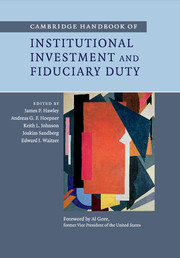Book contents
- Frontmatter
- Contents
- List of figures
- List of tables
- List of contributors
- Foreword
- 1 Introduction
- Part I Fiduciary duty: a global outlook
- Part II Fiduciary duty and the landscape of institutional investment
- Part III Challenging conventional wisdom on fiduciary duty
- 14 Is the search for excessive alpha a breach of fiduciary duty?
- 15 Fiduciary duty and sin stocks:is vice really nice?
- 16 Whose risk counts?
- 17 Sustainability, financial markets and systemic risk
- 18 Uncertain times, plural rationalities and the pension fiduciary
- 19 Emotional finance and the fiduciary responsibility of asset managers
- Part IV Towards a broader interpretation of fiduciary duty
- Part V Beneficiaries’ roles and viewpoints
- Part VI Fiduciary duty and governance
- Index
- References
17 - Sustainability, financial markets and systemic risk
Published online by Cambridge University Press: 05 April 2014
- Frontmatter
- Contents
- List of figures
- List of tables
- List of contributors
- Foreword
- 1 Introduction
- Part I Fiduciary duty: a global outlook
- Part II Fiduciary duty and the landscape of institutional investment
- Part III Challenging conventional wisdom on fiduciary duty
- 14 Is the search for excessive alpha a breach of fiduciary duty?
- 15 Fiduciary duty and sin stocks:is vice really nice?
- 16 Whose risk counts?
- 17 Sustainability, financial markets and systemic risk
- 18 Uncertain times, plural rationalities and the pension fiduciary
- 19 Emotional finance and the fiduciary responsibility of asset managers
- Part IV Towards a broader interpretation of fiduciary duty
- Part V Beneficiaries’ roles and viewpoints
- Part VI Fiduciary duty and governance
- Index
- References
Summary
Introduction
Financial markets serve as a fiduciary for individuals and institutions. Their key strength is to act as an intermediary “able to link and enable people” (Remer 2011: 193). While providing services on the asset and liability side, financial institutions – particularly banks and funds – assume responsibility for their customers (deposit taking, financing) and the environment (capital allocation) as a whole. Fiduciary duties of financial institutions are discussed from the institutions’ commitment to ethical (social responsibility) and/or legal (financial regulation) obligations. Even more important, from a business point of view financial institutions depend on confidence as a “license to operate.” Confidence itself is considered as being closely related to “loyalty” (balance) and “care” (prudence) as two standards of fiduciary behavior (Hawley and Williams 2002: 285, Martin 2009: 550). Therefore, serving as a financial fiduciary is closely linked to an environment of stability and continuity – here referred to as sustainability – both on the side of single institutions (micro) and the system as a whole (macro).
In this chapter, the issue of systemic stability and continuity as a prerequisite for fiduciary services on financial markets is emphasized. The characteristics of sustainability on financial markets as a macro condition for micro fiduciary services are examined. However, referring to sustainability as a concept of equilibrium in the long term, today’s financial markets appear to be mostly incompatible with sustainability. The increasing volatility of prices on financial markets (“boom and bust”), growing imbalances between the financial system and the real economy (“bubbles”) and, in general, the exhibition of a behavior on financial markets highly assumed to be critical (speculation, manipulation, materialism) are all reflexes to an absence of fiduciary responsibility and expose the financial system to existential risk. This has incentivized massive criticism regarding the functional mechanisms of modern financial markets (Lietaer et al. 2012). In an unstable and discontinuous environment, single institutions cannot comply with their fiduciary duties.
- Type
- Chapter
- Information
- Publisher: Cambridge University PressPrint publication year: 2014
References
- 2
- Cited by



